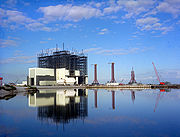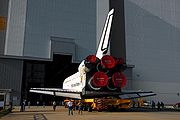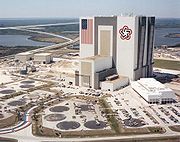
Vehicle Assembly Building
Encyclopedia
The Vehicle Assembly Building, or VAB, at NASA
's Kennedy Space Center
(KSC) was used to assemble and house American manned launch vehicles from 1968-2011. It is the fourth largest building in the world by volume. The building is at Launch Complex 39 at KSC, halfway between Jacksonville
and Miami
, and due east of Orlando
on Merritt Island
on the Atlantic coast
of Florida
.
The VAB is the largest single-story building in the world, was the tallest building in Florida until 1974, and is still the tallest building in the United States outside an urban area.
external fuel tanks
and flight hardware, and was where Space Shuttle orbiters were mated with their solid rocket boosters and external fuel tanks. Once assembled, the complete Space Shuttle was moved on the Mobile Launcher Platform
and Crawler-Transporter
to LC-39 Pad A or B.
 The VAB is 526 feet (160.3 m) tall, 716 feet (218.2 m) long and 518 feet (157.9 m) wide. It covers 8 acres (3 ha), and encloses 129428000 cubic feet (3,664,992.9 m³) of space.
The VAB is 526 feet (160.3 m) tall, 716 feet (218.2 m) long and 518 feet (157.9 m) wide. It covers 8 acres (3 ha), and encloses 129428000 cubic feet (3,664,992.9 m³) of space.
The building has 10,000 tons of air conditioning equipment, including 125 ventilators on the roof supported by four large air handlers (four cylindrical structures west of the building) to keep moisture under control. Air in the building can be completely replaced every hour. The interior volume of the building is so vast that it has its own weather
, including "rain clouds form[ing] below the ceiling on very humid
days", which the moisture reduction systems are designed to minimize.
Located on Florida's Atlantic coast, the building was constructed to withstand hurricanes and tropical storms with a foundation consisting of 30,000 cubic yards of concrete and 4,225 steel rods driven 160 feet into limestone bedrock.
.jpg)
 There are four entries to the bays located inside the building, which are the four largest doors in the world. Each door is 456 feet (139 m) high and takes 45 minutes to completely open or close. The north entry that leads to the transfer aisle was widened by 40 feet (12.2 m) to allow entry of the shuttle orbiter. A central slot at the center of the north entry allowed for passage of the orbiter's vertical stabilizer.
There are four entries to the bays located inside the building, which are the four largest doors in the world. Each door is 456 feet (139 m) high and takes 45 minutes to completely open or close. The north entry that leads to the transfer aisle was widened by 40 feet (12.2 m) to allow entry of the shuttle orbiter. A central slot at the center of the north entry allowed for passage of the orbiter's vertical stabilizer.
To lift the components of the Space Transportation System, the VAB housed five overhead bridge cranes
, including 2 capable of lifting 325 tons, and 136 other lifting devices.
 The American flag
The American flag
painted on the building was the largest in the world when added in 1976 as part of United States Bicentennial
celebrations, along with the star logo of the anniversary, later replaced by the NASA insignia in 1998. It is 209 feet (63.7 m) high, and 110 feet (33.5 m) wide. Each of the stars on the flag is 6 feet (1.83 m) across, the blue field is the size of a regulation basketball court, and each of the stripes is 9 feet (2.74 m) wide, the width of a standard road lane.
Work began in early 2007 to restore the exterior paint on the immense facility. Special attention was paid to the enormous American flag and NASA "meatball" insignia. The work repaired visible damage from years of storms and weathering. The flag and logo had been previously repainted in 1998 for NASA's 40th anniversary.
The most extensive exterior damage occurred during the storm season of 2004, when Hurricane Frances
blew off 850 14 × 6 foot aluminum panels from the building, resulting in about 40000 square feet (3,716.1 m²) of new openings in the sides. Twenty five additional panels were blown off the east side by the winds from Hurricane Jeanne
just three weeks later. Earlier in the season, Hurricane Charley
caused significant but less serious damage, estimated to cost $700,000. Damage caused by these hurricanes was still visible in 2007. Some of these panels are "punch-outs", designed to detach from the VAB when a large pressure differential is created on the outside vs. the inside. This allows for equalization, and helps protect the structural integrity of the building during rapid changes in pressure such as in tropical cyclones.
NASA
The National Aeronautics and Space Administration is the agency of the United States government that is responsible for the nation's civilian space program and for aeronautics and aerospace research...
's Kennedy Space Center
Kennedy Space Center
The John F. Kennedy Space Center is the NASA installation that has been the launch site for every United States human space flight since 1968. Although such flights are currently on hiatus, KSC continues to manage and operate unmanned rocket launch facilities for America's civilian space program...
(KSC) was used to assemble and house American manned launch vehicles from 1968-2011. It is the fourth largest building in the world by volume. The building is at Launch Complex 39 at KSC, halfway between Jacksonville
Jacksonville, Florida
Jacksonville is the largest city in the U.S. state of Florida in terms of both population and land area, and the largest city by area in the contiguous United States. It is the county seat of Duval County, with which the city government consolidated in 1968...
and Miami
Miami, Florida
Miami is a city located on the Atlantic coast in southeastern Florida and the county seat of Miami-Dade County, the most populous county in Florida and the eighth-most populous county in the United States with a population of 2,500,625...
, and due east of Orlando
Orlando, Florida
Orlando is a city in the central region of the U.S. state of Florida. It is the county seat of Orange County, and the center of the Greater Orlando metropolitan area. According to the 2010 US Census, the city had a population of 238,300, making Orlando the 79th largest city in the United States...
on Merritt Island
Merritt Island, Florida
Merritt Island is a census-designated place in Brevard County, Florida, United States. It is located on the east coast of the state on the Atlantic Ocean. As of the 2000 census, the population was 36,090. It is part of the Palm Bay – Melbourne – Titusville, Florida Metropolitan Statistical Area...
on the Atlantic coast
Coast
A coastline or seashore is the area where land meets the sea or ocean. A precise line that can be called a coastline cannot be determined due to the dynamic nature of tides. The term "coastal zone" can be used instead, which is a spatial zone where interaction of the sea and land processes occurs...
of Florida
Florida
Florida is a state in the southeastern United States, located on the nation's Atlantic and Gulf coasts. It is bordered to the west by the Gulf of Mexico, to the north by Alabama and Georgia and to the east by the Atlantic Ocean. With a population of 18,801,310 as measured by the 2010 census, it...
.
The VAB is the largest single-story building in the world, was the tallest building in Florida until 1974, and is still the tallest building in the United States outside an urban area.
History
The VAB was originally built to allow for the vertical assembly of the Saturn V rocket for the Apollo program. It was then used for housing Space ShuttleSpace Shuttle
The Space Shuttle was a manned orbital rocket and spacecraft system operated by NASA on 135 missions from 1981 to 2011. The system combined rocket launch, orbital spacecraft, and re-entry spaceplane with modular add-ons...
external fuel tanks
Space Shuttle external tank
A Space Shuttle External Tank is the component of the Space Shuttle launch vehicle that contains the liquid hydrogen fuel and liquid oxygen oxidizer. During lift-off and ascent it supplies the fuel and oxidizer under pressure to the three Space Shuttle Main Engines in the orbiter...
and flight hardware, and was where Space Shuttle orbiters were mated with their solid rocket boosters and external fuel tanks. Once assembled, the complete Space Shuttle was moved on the Mobile Launcher Platform
Mobile Launcher Platform
The Mobile Launcher Platform or MLP is one of three two-story structures used by NASA to support the Space Shuttle stack during its transportation from the Vehicle Assembly Building to Launch Pad 39-A at the Kennedy Space Center as well as serve as the vehicle's launch platform...
and Crawler-Transporter
Crawler-Transporter
The crawler-transporters are a pair of tracked vehicles used to transport spacecraft from NASA's Vehicle Assembly Building along the Crawlerway to Launch Complex 39. They were originally used to transport the Saturn IB and Saturn V rockets during the Apollo, Skylab and Apollo–Soyuz programs....
to LC-39 Pad A or B.
Construction

The building has 10,000 tons of air conditioning equipment, including 125 ventilators on the roof supported by four large air handlers (four cylindrical structures west of the building) to keep moisture under control. Air in the building can be completely replaced every hour. The interior volume of the building is so vast that it has its own weather
Weather
Weather is the state of the atmosphere, to the degree that it is hot or cold, wet or dry, calm or stormy, clear or cloudy. Most weather phenomena occur in the troposphere, just below the stratosphere. Weather refers, generally, to day-to-day temperature and precipitation activity, whereas climate...
, including "rain clouds form[ing] below the ceiling on very humid
Humidity
Humidity is a term for the amount of water vapor in the air, and can refer to any one of several measurements of humidity. Formally, humid air is not "moist air" but a mixture of water vapor and other constituents of air, and humidity is defined in terms of the water content of this mixture,...
days", which the moisture reduction systems are designed to minimize.
Located on Florida's Atlantic coast, the building was constructed to withstand hurricanes and tropical storms with a foundation consisting of 30,000 cubic yards of concrete and 4,225 steel rods driven 160 feet into limestone bedrock.
Capabilities
.jpg)

To lift the components of the Space Transportation System, the VAB housed five overhead bridge cranes
Crane (machine)
A crane is a type of machine, generally equipped with a hoist, wire ropes or chains, and sheaves, that can be used both to lift and lower materials and to move them horizontally. It uses one or more simple machines to create mechanical advantage and thus move loads beyond the normal capability of...
, including 2 capable of lifting 325 tons, and 136 other lifting devices.
Exterior

Flag of the United States
The national flag of the United States of America consists of thirteen equal horizontal stripes of red alternating with white, with a blue rectangle in the canton bearing fifty small, white, five-pointed stars arranged in nine offset horizontal rows of six stars alternating with rows...
painted on the building was the largest in the world when added in 1976 as part of United States Bicentennial
United States Bicentennial
The United States Bicentennial was a series of celebrations and observances during the mid-1970s that paid tribute to the historical events leading up to the creation of the United States as an independent republic...
celebrations, along with the star logo of the anniversary, later replaced by the NASA insignia in 1998. It is 209 feet (63.7 m) high, and 110 feet (33.5 m) wide. Each of the stars on the flag is 6 feet (1.83 m) across, the blue field is the size of a regulation basketball court, and each of the stripes is 9 feet (2.74 m) wide, the width of a standard road lane.
Work began in early 2007 to restore the exterior paint on the immense facility. Special attention was paid to the enormous American flag and NASA "meatball" insignia. The work repaired visible damage from years of storms and weathering. The flag and logo had been previously repainted in 1998 for NASA's 40th anniversary.
The most extensive exterior damage occurred during the storm season of 2004, when Hurricane Frances
Hurricane Frances
Hurricane Frances was the sixth named storm, the fourth hurricane, and the third major hurricane of the 2004 Atlantic hurricane season. The system crossing the open Atlantic during mid to late August, moving to the north of the Lesser Antilles while strengthening. Its outer bands affected Puerto...
blew off 850 14 × 6 foot aluminum panels from the building, resulting in about 40000 square feet (3,716.1 m²) of new openings in the sides. Twenty five additional panels were blown off the east side by the winds from Hurricane Jeanne
Hurricane Jeanne
Hurricane Jeanne was the deadliest hurricane in the 2004 Atlantic hurricane season. It was the tenth named storm, the seventh hurricane, and the fifth major hurricane of the season, as well as the third hurricane and fourth named storm of the season to make landfall in Florida...
just three weeks later. Earlier in the season, Hurricane Charley
Hurricane Charley
Hurricane Charley was the third named storm, the second hurricane, and the second major hurricane of the 2004 Atlantic hurricane season. Charley lasted from August 9 to August 15, and at its peak intensity it attained 150 mph winds, making it a strong Category 4 hurricane on the...
caused significant but less serious damage, estimated to cost $700,000. Damage caused by these hurricanes was still visible in 2007. Some of these panels are "punch-outs", designed to detach from the VAB when a large pressure differential is created on the outside vs. the inside. This allows for equalization, and helps protect the structural integrity of the building during rapid changes in pressure such as in tropical cyclones.

